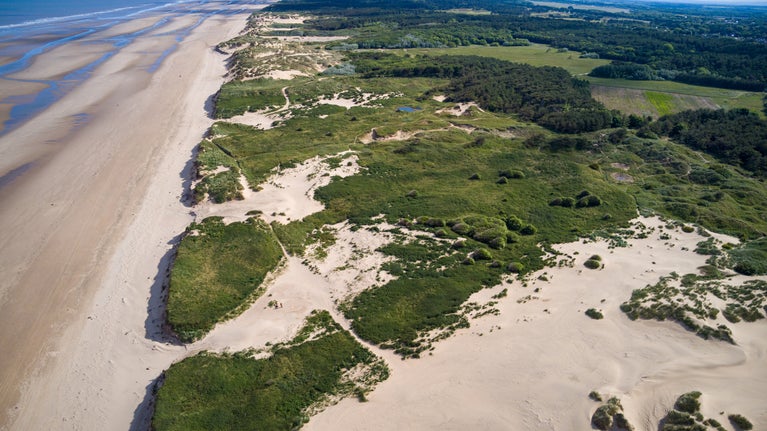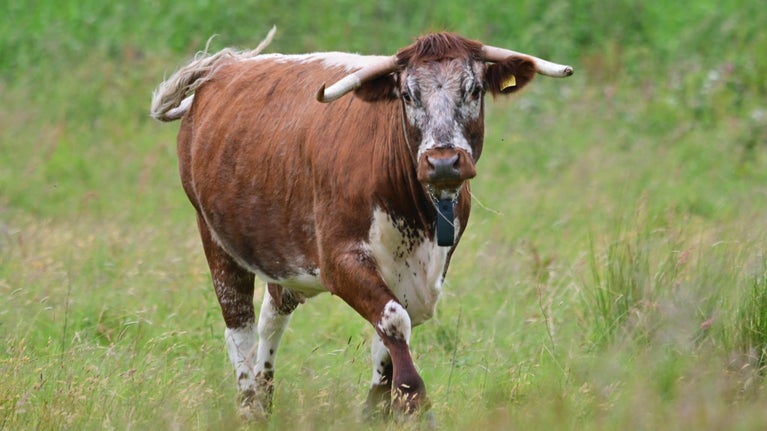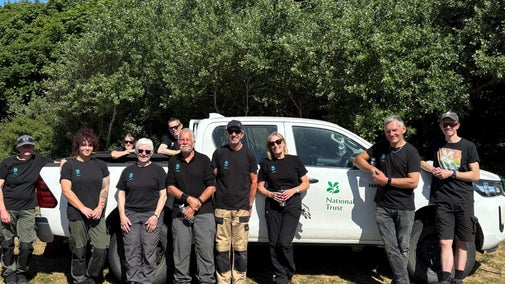
Discover more at Formby
Find out how to get to Formby, where to park, the things to see and do and more.

Formby is one of the fastest changing stretches of coastline under the National Trust’s care. Discover how we're working with nature to restore rare habitats and create space for wildlife to thrive.
Victoria Road car park closed until spring 2026 for conservation work - no pedestrian access through the work site. Please don’t travel to us by car on sunny days. Get the train to Formby station or visit alternative beaches along the Sefton and Wirral Coast. Thanks for your understanding whilst we enhance this special space.
Formby is part of the Sefton Coast, one of the biggest sand dune systems in England and also one of the few that we have in the UK which is still mobile and dynamic - constantly moving and shifting. This creates a special mosaic of habitats and a haven for rare dune wildlife including natterjack toads, sand lizards and northern dune tiger beetles.
A dynamic sand dune system can also act as a natural sea defence by moving and shifting to form protection against the tide and sea as it comes in.
The coastline here is legally protected internationally and also in the UK as a Site of Special Scientific Interest (SSSI). This means we need to get permission for any of the work we do on site and often work in partnership to care for this special place.
Watch Lead Ranger Kate talk about the impact of coastal change at Formby.
We ask for your permission before anything is loaded, as this content may introduce additional cookies. You may want to read the Google YouTube terms of service and privacy policy before accepting.
“When people hear about coastal change, especially erosion, it's natural to want to find ways to stop it. But rather than resisting these changes, we focus on understanding and adapting to the natural processes that shape the coastline”.
Formby’s ever-changing coastline tells a powerful story — shaped by wind, tide and time. Decades ago, the ecological value of coastlines across the UK was often overlooked. At Formby, land use focused on commercial ventures such as sand mining, pine tree plantations and asparagus farming. Remnants of industry and war were dumped here and the absence of natural grazing by large herbivores became increasingly noticeable. Over time these elements combined have disrupted the delicate balance of the landscape.
Since 1967, we’ve been working to turn the tide. With climate change accelerating coastal change and threatening rare species, the need to act is more urgent than ever. By caring for Formby’s precious habitats, we’re helping nature to heal and protecting native wildlife. Our conservation efforts are restoring natural processes, reconnecting habitats, encouraging biodiversity, and building a more resilient coastline for wildlife and people.
Conservation challenge - Thousands of years ago, large herbivores naturally grazed the landscape on our coastline, helping to keep it open and maintain areas of bare, shifting sand. These dynamic conditions are essential for rare dune wildlife such as natterjack toads and sand lizards to thrive.
Without grazing or active management, invasive scrub species—including sea buckthorn, Rosa rugosa (Japanese rose), and grey poplar—can quickly take over. If left unchecked they can smother the dune habitat, over-stabilise areas of sand, and prevent native plants from growing.
Progress update – A key part of our on-going conservation work at Formby involves removing areas of invasive scrub to protect the natural balance of the dunes and the rare wildlife that depends on them.
This autumn we’re removing dense clusters of grey poplar in the Lifeboat Road area to restore and reconnect the rare dune grassland habitat here.
Areas of invasive grey poplar were spreading in this area, threatening rare dune grasslands by turning them into woodland and drying out vital dune pools—essential breeding sites for natterjack toads. Their aggressive root systems allow them to quickly outcompete native plants and disrupt the delicate ecosystem.
By removing dense clusters of grey poplar, we’re helping nature restore the rare mosaic of habitats found in a dynamic and healthy dune landscape - making sure the space remains mainly open, with patches of bare sand. We’ll leave small areas of native scrub like hawthorn and willow, which add some shelter for wildlife and diversity to the space.

Over autumn and winter 2025 we’re excited to be trialling cattle grazing in the Ravenmeols area of the dune grasslands south of Devil’s Hole. We hope to continue grazing each winter as this should help ensure invasive species like grey poplar don’t take hold in the future.
We’re delighted to be working in partnership with Lancashire Wildlife Trust and 8 cattle from their charming herd of English longhorn cattle. The animals will be on site from early November until April 2026.
English longhorns are one of Britain’s oldest established native breeds. Often described as gentle giants, they are known for their calm and placid nature. Their resilience and ability to graze and browse a wide range of vegetation make them ideal for conservation grazing. Hardy and adaptable, they thrive in the coastal climate and rugged terrain of the dunes.
Having grazed nearby public areas such as Freshfield Dune Heath to the north and Cabin Hill to the south, the herd are well used to being around people and dogs. Only the most passive animals have been selected to graze here.
The cattle are trained to be safely contained using a virtual fencing system. Each animal wears a GPS collar that gently guides them with sound cues, allowing them to graze freely while staying within invisible boundaries. This technology is designed with animal welfare in mind— allowing the cattle to graze in a more natural and relaxed environment, reducing stress levels.
For livestock assistance or in the event of a livestock emergency please call: 07712 232811 or 07871 987248.
Mobile areas of sand are a vital part of a healthy dune habitat, but for many years unnatural elements including tonnes of rubble and tobacco waste have been creating a barrier for these natural processes, making some of the dunes too stable and disconnected.
As part of the Dynamic Dunescapes UK-wide project we’re working with nature to repair this damage. The vision is to create space for sand to move more freely, which will restore natural processes and create healthier habitats for many important and rare species.
Conservation challenge - rubble that made up the foundation of the old Victoria Road beach car park was preventing sand from moving as it should – disconnecting wildlife habitats and limiting beach access for people.
Progress update – we’ve reached a major milestone in our conservation work at Victoria Road—with over 80,000 tonnes of old construction rubble now removed from the dunes. With most of the rubble gone, we’re working with dune experts to shape the landscape, placing the stockpiled sand to mimic natural dune contours and help kickstart ecological processes.
It may look a bit stark for now, but nature is resilient. We’ll be working with our regular volunteers this autumn to place brushwood fencing to trap wind-blown sand, which will help stablise areas of the dunes. We may also plant marram grass if it doesn't start to colonise naturally.
Work is also continuing on the replacement car park, as well as mapping new walking routes and installing new signs and infrastructure to help you find your way and protect the dune habitat during the restoration process.
The Victoria Road car park and work site area will remain closed until spring 2026.
Find out more about the Victoria Road project and impact on your plans to visit here
Conservation challenge - tobacco waste dumped between the 1950s and 1970s in the Victoria Road area of the dunes was blocking natural sand movement and creating a nutrient rich compost. Over time a dense blanket of rank vegetation had taken over. The flat sea of nettles was unnatural and fragmenting precious habitats - there was very little natural dune vegetation or wildlife in this area.
Progress update - Back in 2022 we worked with specialist contractors to create two ‘notches’ or large wedge-shaped gaps in the dunes where the tobacco waste is creating a barrier for natural sand movement. They replicate the natural undulations found in some of Formby's healthy frontal sand dunes. The notches are funnelling wind-blown sand from the beach up over the dunes over-topping the tobacco leaf waste and rank vegetation.
This is helping to kick start natural processes by allowing sand to shift and shape more freely over time and for marram grass to recolonise naturally. The aim is to restore a more natural dune habitat. We’re continuously monitoring the changes in this area and may need to do further re-grading of the notches in the future as the coastline continues to change naturally.
Conservation challenge – natterjack toads are a rare and declining species that require very specific conditions to breed successfully. At Formby, the number of suitable slacks had become limited, with encroaching vegetation further degrading the habitat and negatively affecting breeding conditions.
Progress update – Over the past few years, as part of the Gems in the Dunes and Dynamic Dunescapes nationwide projects, we’ve been restoring and creating new natterjack toad breeding slacks or pools to give this rare amphibian the best opportunity to increase their declining population.
We now have 25 slacks at Formby, providing a network of different options for breeding in various weather conditions, helping give natterjack toads the best chance of success. The pools have a double layer of stock fencing around them to create a safe, undisturbed breeding space.
Each winter, when natterjack toads and sand lizards are safely tucked away hibernating, we carry out on-going maintenance of the slacks. This includes removing overgrown vegetation to help create the conditions natterjack toads need to thrive.
Conservation challenge - the Larkhill area of Formby’s nature haven is a popular spot for dog walking and family fun. Hidden away behind the main field is an area that is protected as a Site of Special Scientific Interest (SSSI). Over time invasive scrub including gorse and birch trees had taken over, smothering the ground and stopping native plants growing, including heather.
Progress update – our vision is to restore this space into dune heath – one of the rarest habitats along the Sefton coast.
By working with fantastic volunteers and specialist contractors over the last few years we've removed significant amounts of invasive shrubs and trees, including gorse and birch. This has opened up the area, let in more light and created the space native wildlife needs to thrive. Revealing the seed bed underneath is helping prompt the natural growth of heather and other special wildflowers and plants.
The conservation work at Larkhill is ongoing and will take a while as the scrub can only be cut during the winter, outside the nesting bird season. The area will look a bit stark in the short term but nature will quickly embrace the space, and you’ll soon see signs of the thriving, healthy and diverse habitat that we are aiming to create.
Conservation challenge - natural coastal change is squeezing the dune habitat against the plantation woodlands. This squeeze is limiting space and restricting the movement of the dunes. Sand dunes need to be free to move, as this creates the habitats that rare species like sand lizards need. Trees on the border of the mobile dunes are also being suffocated by the sand and dying.
Progress update - In 2022 we created dune corridors to make space for the sand dune habitat to move and thrive by removing trees that were dead or dying due to the sand suffocating their roots. This work is helping these two special habitats coexist.
We share lots of updates about the conservation work happening at Formby on our website and social media (Facebook and Instagram @NTFormby) to help you plan your visit. From time to time, you might notice heavy machinery on site including tractors, diggers or trailers, as well as specialist contractors lending a hand with more complex work. To keep everyone safe, we may need to temporarily close some paths—but we’ll always do our best to keep disruption to a minimum.
The results of conservation work can sometimes look a little stark at first, but over time nature will embrace the space, creating a healthier habitat where wildlife can thrive.
Look out for information boards near to where work is happening for more details. We also install signs to highlight areas to keep a safe distance from and where it’s best to put your dog on a lead, as well as alternative routes to take.
Every time you pay to park, scan your membership card, give your time as a volunteer or simply take your litter home with you, you’re supporting important conservation work like this. Together we can protect Formby’s wildlife so that it’s here for everyone to enjoy, for ever. Thank you.

Find out how to get to Formby, where to park, the things to see and do and more.

Inspiring, leading and resourcing the UK’s heritage to create positive and lasting change for people and communities, now and in the future.

Restoring sand dunes across England and Wales for the benefit of people, communities and wildlife.
Find out what's happening at Formby's nature haven and get involved. Together we can shape future plans to protect this precious landscape and the rare species that call it home.
Explore how dedicated volunteers help to keep Formby thriving through all seasons, how you can get involved and what’s in it for you.

Formby’s coastline is home to many rare species, two shipwrecks and prehistoric footprints. Can you spot a red squirrel in the trees or footprints on the shoreline?

Formby is steeped in history if you know where to look. Discover the history of Formby’s asparagus fields, prehistoric footprints and shipwrecks.

Horses are welcome at Formby. Find out all your need to know about riding your horse on the beach or through the woodlands.

Read about our strategy, which focuses on restoring nature, ending unequal access and inspiring more people.

We believe that nature, beauty and history are for everyone. That’s why we’re supporting wildlife, protecting historic sites and more. Find out about our work.
